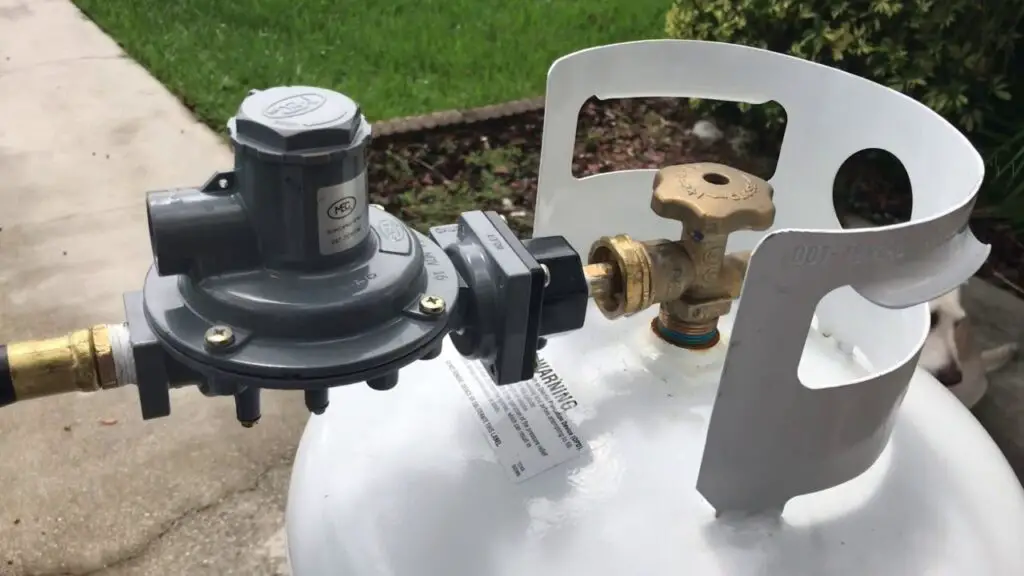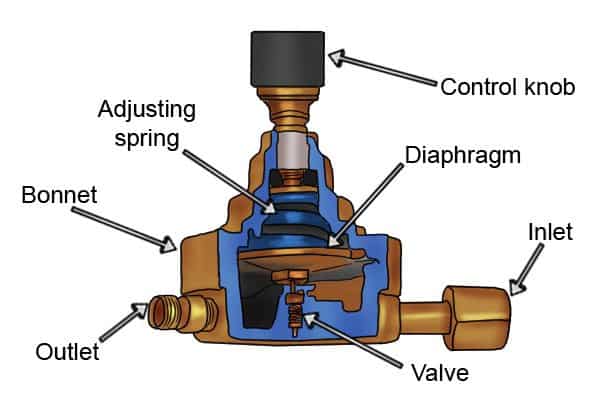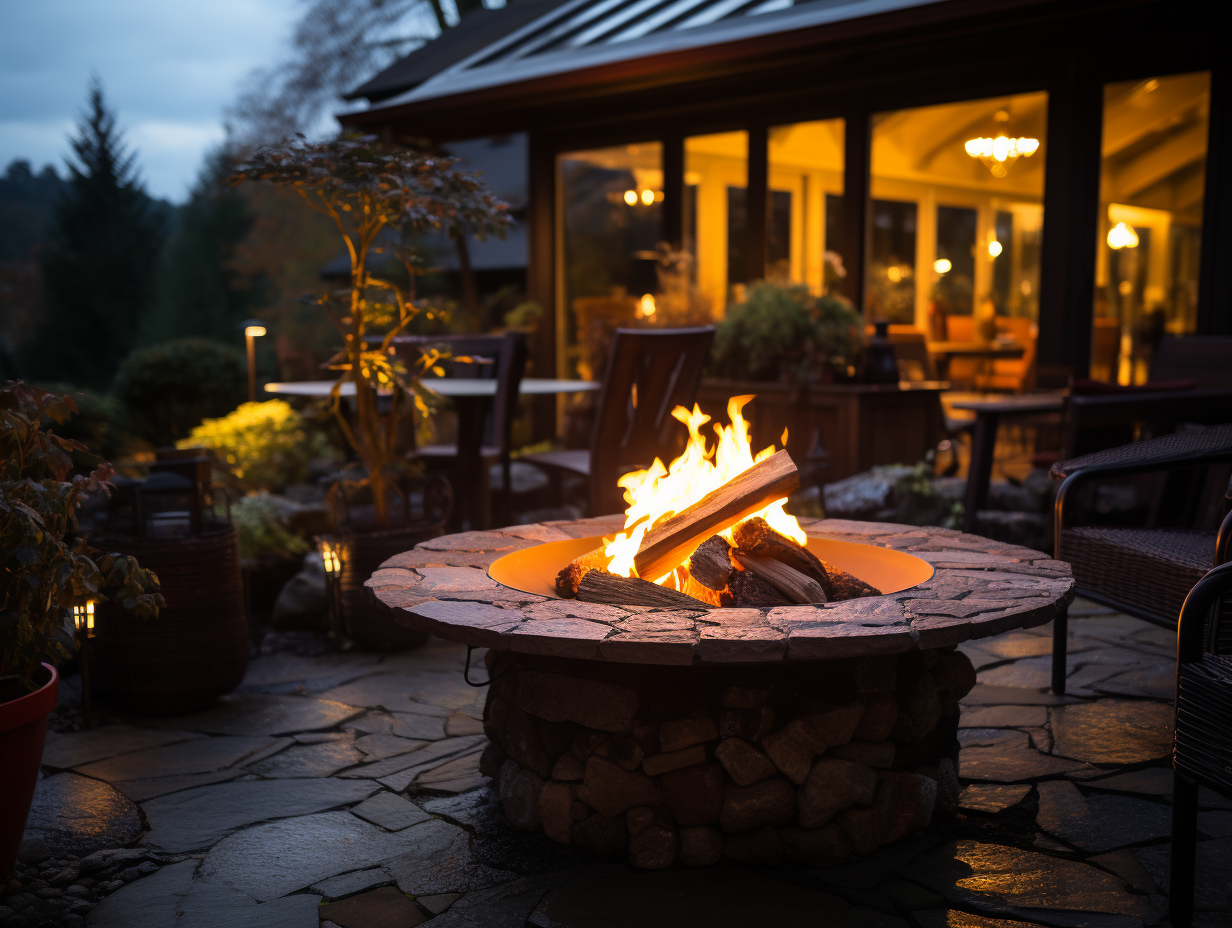Gas regulators are a popular product for fire pits and other outdoor gas appliances. It is a safety device that helps to regulate the pressure of the gas going into your appliance, making sure it doesn’t get too high or low.
But do you need a gas regulator on a fire pit? And if so, how do you know which one to use?
In this blog post, we will discuss what a gas regulator does and when you might want to consider using one on your fire pit!

Do You Need A Gas Regulator On A Fire Pit?
If you have a 20 lb. propane tank like the ones most commonly used on a gas fire pit, you’ll need a regulator to connect it to.
When using gas, particularly propane or natural gas for a fire pit, good gas pressure is required for optimum fire pit performance. A pressure regulator is sometimes necessary in order to get the most out of it.
However, if you’re using natural gas or connecting to a large propane tank (such as a 500-gallon tank if you live in the country), those types of gas lines should be regulated in collaboration with your gas plumber.
Regulators aren’t “universal” in the sense that gas pressure and BTU output will vary depending on the distance the gas needs to travel, the size of the gas line, how many appliances are on the line, and so on.
This is why it’s critical to work with a gas professional to ensure they’ve taken into account all of the variables to properly supply your fire pit.
Failure to do so may result in your fire pit making a whistling noise.
Read More: [Stop It!] Why Does My Fire Pit Whistle?
What Is A Regulator?
A gas regulator is essentially the flow control valve for your propane tank. It controls the amount of propane that is released to the appliance you are using.
The reason why it’s important to have a quality gas regulator installed on your propane tank is that it regulates the pressure inside of the tank based on what appliance you are using at any given time.

How does it work?
Some people refer to it as a flow control valve, some call it a regulator. The more technical term that describes exactly what this device does—is “flow control valve.”
Simply put, think of this little device as an artery constricting blood flow from one part of your body to another by squeezing together tightly with each beat of your heart (just like it does with propane).
The Flow Of Propane (or the amount of “gas” coming from your tank) is regulated by a spring-loaded device that moves up and down in response to the pressure inside the regulator.
When you turn on the gas tank, the internal spring compresses and releases gas through an orifice onto a small disk at precisely calibrated intervals.
The force of this flow pushes against another smaller disk which begins to move back and forth much like a leaf valve in a garden hose.
The movement of this second disk opens and closes an outside port that sends propane to your appliance—allowing just the right amount of gas to pass into the burner chamber before closing again.
It then waits for more gas pressure behind its closed doors to build up once again before re-opening and releasing more propane.
Now that you know what a gas regulator is and does let’s get down to the burning question:
Regulators for Propane
As previously stated, a common fuel source for backyard gas fire pits is a standard 20 lb. (5 gallons) propane tank, similar to that used for a gas grill.
Because these tanks can produce up to 125,000 BTUs, it is critical to use a properly sized burner ring when using this type of tank.
Larger propane tanks (again, most commonly found in rural areas) will require a gas line running to your fire pit regulator.
However, because the gas line presumably also fuels your home, it has already been regulated for common household appliances – typically between 8″ – 11″ Water Column (almost 1/2 PSI), which is what our fire pit kits require, so the only thing your gas plumber needs to ensure is that you have enough BTU to supply your fire pit.
Read More: Cost To Run A Gas Line To A Fire Pit & Grill
Regulators for Natural Gas
Because most urban/suburban areas have natural gas lines, this is the most common fuel type for built-in units.
Depending on the size of your home or the number of appliances you must supply (again, pool heaters, etc.), your gas source (the meter on the side of your home) could be regulated anywhere from 3.5-inches Water Column on up – but it’s usually around 7-inches.
As with large propane tanks, if you have a gas line running to your fire pit, it will almost certainly need to be regulated in order to properly supply the appliance. However, how it is regulated will be determined by your gas plumber.
If your fire pit is only 10 feet from the meter, it may not need to be regulated; however, if the gas line is supplying a pool heater or other appliance, or if it is traveling a long distance, your gas plumber will need to regulate the gas line accordingly.
What Size Regulator Do I Need For A Gas Fire Pit?
The vast majority of propane-fueled fire pits are connected using either 1/2-inch or 3/8-inch threaded connections.
A few models connect using larger, 5/8-inch connections, but these are relatively rare. Some units may use other types of fittings, but these are the ones that you should be concerned with if you’re shopping for a new fire pit.
1/2-inch Fire Pit Regulator (Amazon)
3/8-inch Fire Pit Regulator (Amazon)
If your unit uses anything other than one of these three connection types, you should refer to the product documentation or contact the manufacturer before attempting to use it with a propane regulator.
What Type Regulator Do I Need For My Gas Fire Pit?
You will need a regulator that has an adjustable PSI from 0 – 30 PSI. The vast majority of professional-grade regulators are adjustable from 0 – 30 PSI (pounds per square inch).
View The Latest Fire Pit Regulators Here
There are some specialty models available which can handle higher pressures, but they tend to be less common and will usually say so in the product description.
When choosing a regulator, you’ll want to keep in mind that there are three primary uses for it: High-pressure gas lines have a “high” PSI rating, typically between 40 – 80 PSI.
A typical house’s natural gas line has a relatively low psi rating between 20 and 60 psi. Low-pressure gas lines have a “low” PSI rating which is usually 10 or less.
Specialty torches, such as those used with propane or MAPP-fueled cutting elements, require an even lower psi rating than low-pressure lines.
In many cases, this type of torch can function at 0 – 5 psi (although it will perform poorly under these conditions).
If you on using your fire pit with one of these torches, you’ll need to get a regulator with a 0 – 10 PSI rating.
What Is The Cost Of A Gas Regulator For My Fire Pit?
If you are looking for a gas regulator (also called a propane regulator) for your fire pit, here is everything you need to know.
There is no such thing as a “standard” cost of a gas regulator for your fire pit or outdoor gas appliances like grills and patio heaters. This is because there are so many different sizes and types (read: BTU/hr input) of both standard and stainless steel regulators available.
Depending on what size and type of the regulator(s), it could range anywhere from less than $10 to more than $50, but it will depend on where you buy them.
We found the cheapest ones online Here
What Happens If You Don’t Use A Gas Regulator?
If you don’t use a regulator you run the risk of your gas pressure being too high or too low.
Too much pressure can cause damage to your regulator, tank valve, or cylinder filler. We have seen many occasions when people have blown their regulators right off of the cylinders because they didn’t use a regulator, so it’s wise to always use one.
Another issue with too much gas pressure is that you may not be able to open your cylinder valve fast enough before the regulator vents the excess gas back into its storage vessel.
This creates a very dangerous situation in which high-pressure gas is being rapidly released from your system into an area that could easily be occupied by someone else.
It would only take a fraction of a second for this sudden release of pressurized gas to strike another person in the face and create serious injury.

![What Gravel To Use For Patio Base [Best Options]](https://www.cleverpatio.com/wp-content/uploads/2021/11/What-Gravel-To-Use-For-Patio-Base-270x180.jpg)


Leave a Reply